Surpassing the US$ 210 million mark in 2021, the global blood temperature indicator market is poised to witness further growth, with sales projected to soar to US$ 235 million by 2022, boasting a remarkable Compound Annual Growth Rate (CAGR) of nearly 12% to 13% throughout the assessment period from 2022 to 2032.
North America is poised to take the lead as the most lucrative market for blood temperature indicators, with projections spanning from 2022 to 2032. The region’s prominence in this market is attributed to a growing emphasis on maintaining the appropriate temperature of blood bags during storage and transportation to ensure the quality of blood. This heightened focus has triggered a swift surge in demand for blood temperature indicators.
To capitalize on this expanding demand, notable manufacturers are strategically pursuing merger and acquisition endeavors to diversify their product offerings. An illustrative case is Zebra Technologies, an American provider of real-time monitoring solutions. In 2019, Zebra Technologies acquired Temptime Corporation, a manufacturer of temperature monitoring solutions. This strategic move augmented their product portfolio, specifically in the domain of medical temperature indicating devices. Such developments are expected to facilitate and bolster the growth of the blood temperature indicator market in North America.
South Asia is poised to play a pivotal role in the global blood temperature indicators market, making significant strides from 2022 to 2032, as noted by Future Market Insights (FMI). The region’s prominence is driven by the escalating incidence of road accidents and the increasing burden of blood-related diseases, which have led to a substantial rise in blood transfusion activities across Asia Pacific.
This surge in blood and blood component demand has created a robust market for associated medical devices, including blood temperature indicators. To illustrate, in India, where the Friends2support Organization reports an annual requirement of approximately 50 million units of blood and around 30 million units of blood components, blood temperature indicators are employed on nearly every blood bag. As such, the growing demand for blood and its components is poised to provide a favorable tailwind to the South Asia blood temperature indicator market’s growth.
Request Free Sample Report: https://www.futuremarketinsights.com/reports/sample/rep-gb-9724
Blood Temperature Indicator Market: Key Players
Examples of some of the key players operating in the global blood temperature indicator market are:
- Temptime Corporation,
- Elitech,
- Timestrip UK Ltd.,
- Hanwell Solutions Ltd.,
- Lisaline Lifescience Technologies Pvt. Ltd.
Key Drivers-
- Increasing Blood Transfusion Activities: The rising need for blood and blood components due to road accidents, surgeries, and blood-related diseases is fueling the demand for blood temperature indicators to maintain the quality of stored blood.
- Quality Assurance: Blood temperature indicators are crucial for ensuring the safety and quality of blood and its components, driving their adoption in healthcare facilities and blood banks.
- Regulatory Compliance: Stringent regulations and guidelines related to blood storage and transportation are compelling healthcare institutions to use blood temperature indicators for compliance and safety.
- Technological Advancements: Ongoing advancements in blood temperature indicator technology are enhancing their accuracy and efficiency, making them more attractive to end-users.
- Growing Awareness: Increasing awareness about the importance of maintaining proper blood storage conditions is leading to greater adoption of blood temperature indicators in the healthcare sector.
Future Prospects of Blood Temperature Indicators
The future of the Blood Temperature Indicator Market looks promising, with ongoing advancements in sensor technology, data analytics, and connectivity. As these devices become more sophisticated and accessible, their adoption is likely to skyrocket, transforming patient care across the globe.
Major Restraints-
- Budget Constraints: Healthcare facilities, especially in resource-constrained regions, may face budget limitations, making it challenging to invest in expensive blood temperature indicator systems.
- Limited Awareness: Some healthcare providers and institutions may have limited awareness of the benefits and necessity of blood temperature indicators, leading to slower adoption rates.
- Technical Expertise: Implementing and maintaining blood temperature indicator systems may require technical expertise, which can be a barrier for smaller healthcare facilities.
- Regulatory Compliance Costs: Meeting regulatory standards for blood storage can be costly, particularly for smaller blood banks and clinics, impacting their ability to invest in temperature indicator technology.
- Alternative Solutions: Some healthcare facilities may opt for alternative methods to monitor blood temperature, such as manual checks, which can deter investment in specialized blood temperature indicator systems.
Ready to Learn About Our Approach? Explore Our Methodology: https://www.futuremarketinsights.com/request-report-methodology/rep-gb-9724
Blood Temperature Indicator Market: Segmentation
By Material:
- Polypropylene (PP)
- Polyethylene (PE)
- Others
By Threshold Temperature Range:
- Up to 2°C
- 2°C to 4°C
- 5°C to 7°C
- Above 7°C
By End Use:
- Hospitals
- Clinics
- Blood Banks
- Blood Collection Centers
- Diagnostics Lab
- Others
About Future Market Insights (FMI)
Future Market Insights, Inc. (ESOMAR certified, recipient of the Stevie Award, and a member of the Greater New York Chamber of Commerce) offers profound insights into the driving factors that are boosting demand in the market. FMI stands as the leading global provider of market intelligence, advisory services, consulting, and events for the Packaging, Food and Beverage, Consumer, Technology, Healthcare, Industrial, and Chemicals markets. With a vast team of over 5000 analysts worldwide, FMI provides global, regional, and local expertise on diverse domains and industry trends across more than 110 countries.
Contact Us:
Future Market Insights Inc.
Christiana Corporate, 200 Continental Drive,
Suite 401, Newark, Delaware – 19713, USA
T: +1-845-579-5705
For Sales Enquiries: sales@futuremarketinsights.com
Website: https://www.futuremarketinsights.com
LinkedIn| Twitter| Blogs | YouTube

